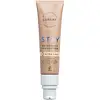What's inside
What's inside
 Key Ingredients
Key Ingredients

 Benefits
Benefits

 Concerns
Concerns

 Ingredients Side-by-side
Ingredients Side-by-side

Water
Skin ConditioningCaprylyl Methicone
Skin ConditioningZinc Oxide
Cosmetic ColorantLauryl PEG-10 Tris(Trimethylsiloxy)Silylethyl Dimethicone
EmulsifyingCaprylic/Capric Triglyceride
MaskingSilica
AbrasiveIsododecane
EmollientEthyl Oleate
EmollientButylene Glycol
HumectantPolyhydroxystearic Acid
EmulsifyingMagnesium Sulfate
Betaine
HumectantEmpetrum Nigrum Fruit Juice
Skin ConditioningDimethicone
EmollientPhenoxyethanol
PreservativeTrimethylsiloxysilicate
EmollientDisteardimonium Hectorite
StabilisingHydrogenated Vegetable Oil
EmollientNeopentyl Glycol Diethylhexanoate
EmollientPolypropylsilsesquioxane
Propanediol
SolventCetearyl Dimethicone Crosspolymer
Propylene Carbonate
SolventTriethoxycaprylylsilane
Ethylhexylglycerin
Skin ConditioningGlycerin
HumectantBiosaccharide Gum-1
HumectantPotassium Sorbate
PreservativeIron Oxides
CI 77891
Cosmetic ColorantWater, Caprylyl Methicone, Zinc Oxide, Lauryl PEG-10 Tris(Trimethylsiloxy)Silylethyl Dimethicone, Caprylic/Capric Triglyceride, Silica, Isododecane, Ethyl Oleate, Butylene Glycol, Polyhydroxystearic Acid, Magnesium Sulfate, Betaine, Empetrum Nigrum Fruit Juice, Dimethicone, Phenoxyethanol, Trimethylsiloxysilicate, Disteardimonium Hectorite, Hydrogenated Vegetable Oil, Neopentyl Glycol Diethylhexanoate, Polypropylsilsesquioxane, Propanediol, Cetearyl Dimethicone Crosspolymer, Propylene Carbonate, Triethoxycaprylylsilane, Ethylhexylglycerin, Glycerin, Biosaccharide Gum-1, Potassium Sorbate, Iron Oxides, CI 77891
Aloe Barbadensis Leaf Juice
Skin ConditioningDicaprylyl Carbonate
EmollientIsoamyl Laurate
EmollientZinc Oxide
Cosmetic ColorantButylene Glycol
HumectantPolyglyceryl-3 Polyricinoleate
EmulsifyingOryza Sativa Bran Oil
EmollientVegetable Oil
Skin ConditioningHelianthus Annuus Seed Wax
Skin ConditioningOryza Sativa Bran Wax
Skin ConditioningRhus Succedanea Fruit Wax
Polyglyceryl-3 Diisostearate
EmulsifyingSodium Chloride
MaskingSodium PCA
HumectantXanthan Gum
EmulsifyingSodium Dehydroacetate
PreservativePaeonia Lactiflora Root Extract
Skin ConditioningVaccinium Myrtillus Fruit Extract
Skin ConditioningAluminum Hydroxide
EmollientAroma
Glycolipids
Skin ConditioningHydrolyzed Hyaluronic Acid
HumectantSodium Hyaluronate
HumectantAscorbyl Palmitate
AntioxidantTocopherol
AntioxidantPotassium Hydroxide
BufferingLimonene
PerfumingLinalool
PerfumingCI 77891
Cosmetic ColorantCI 77491
Cosmetic ColorantCI 77492
Cosmetic ColorantCI 77499
Cosmetic ColorantAloe Barbadensis Leaf Juice, Dicaprylyl Carbonate, Isoamyl Laurate, Zinc Oxide, Butylene Glycol, Polyglyceryl-3 Polyricinoleate, Oryza Sativa Bran Oil, Vegetable Oil, Helianthus Annuus Seed Wax, Oryza Sativa Bran Wax, Rhus Succedanea Fruit Wax, Polyglyceryl-3 Diisostearate, Sodium Chloride, Sodium PCA, Xanthan Gum, Sodium Dehydroacetate, Paeonia Lactiflora Root Extract, Vaccinium Myrtillus Fruit Extract, Aluminum Hydroxide, Aroma, Glycolipids, Hydrolyzed Hyaluronic Acid, Sodium Hyaluronate, Ascorbyl Palmitate, Tocopherol, Potassium Hydroxide, Limonene, Linalool, CI 77891, CI 77491, CI 77492, CI 77499
 Reviews
Reviews

Ingredients Explained
These ingredients are found in both products.
Ingredients higher up in an ingredient list are typically present in a larger amount.
Butylene Glycol (or BG) is used within cosmetic products for a few different reasons:
Overall, Butylene Glycol is a safe and well-rounded ingredient that works well with other ingredients.
Though this ingredient works well with most skin types, some people with sensitive skin may experience a reaction such as allergic rashes, closed comedones, or itchiness.
Learn more about Butylene GlycolCi 77891 is a white pigment from Titanium dioxide. It is naturally found in minerals such as rutile and ilmenite.
It's main function is to add a white color to cosmetics. It can also be mixed with other colors to create different shades.
Ci 77891 is commonly found in sunscreens due to its ability to block UV rays.
Learn more about CI 77891Zinc Oxide is a mineral broad-spectrum UV filter; it is the broadest UVA and UVB reflector approved by the FDA. It also has skin protectant and skin soothing properties.
Zinc oxide is one of the most effective broad-spectrum UV filters. It protects against UVB, UVAII, and UVAI. In comparison to its counterpart titanium dioxide, zinc oxide provides uniform and extended UVA protection.
Another great benefit? This ingredient is highly photostable so it won't degrade easily under sunlight.
A common myth is that mineral UV filters are widely believed to primarily reflect UV light.
However, modern research shows titanium dioxide absorbs UV radiation like chemical filters (~95% absorption & 5% reflection).
Zinc oxide has great skin soothing properties so you'll likely find this in sunscreens formulated for sensitive skin or babies/children. It is unlikely to cause "eye sting" like other sunscreen ingredients.
Regulatory agencies consider zinc oxide to be non-toxic and safe. It has also been shown to not penetrate the skin.
Unfortunately, this ingredient does leave a visible white cast. This is why mineral sunscreens are often less cosmetically elegant than chemical or hybrid ones.
In cosmetics, zinc oxide can be found in both non-nano and nano-sized forms. The nano version is used to reduce white cast and improve the texture of sunscreen formulas.
There are ongoing concerns surrounding nano-zinc oxide's impact on marine ecosystems and whether it can be absorbed into skin.
Regarding marine ecosystems and coral reefs, there is no conclusive evidence that any form of zinc oxide (or any other sunscreen ingredients) will cause harm. The science is still developing but many consumers are keeping a close eye on this issue.
Please note, many destinations have reef-safety sunscreen rules. For instance, the U.S. Virgin Islands advises all visitors to use non-nano mineral sunscreens.
There has also been some stir about whether micronized or nano zinc oxide has potential photoxicity and absorption through the skin/lungs.
An in-vitro (done in a test tube or petri dish) study demonstrated micronized zinc oxide to have potential phototoxicity. There's no need to fret; the EU Commission's Scientific Committee on Consumer Safety has stated, "The relevance of these findings needs to be clarified by appropriate investigations in vivo." Or in other words, further studies done on living organisms are needed to prove this.
Current research shows zinc oxide nanoparticles do not penetrate intact or sunburned skin. They either remain on the surface or in the outermost layer of dead skin (stratum corneum).
Zinc oxide is one of only two classified mineral UV filters with titanium dioxide being the other one.
Fun fact: Zinc has been used throughout history as an ingredient in paint and medicine. An Indian text from 500BC is believed to list zinc oxide as a salve for open wound. The Ancient Greek physician Dioscorides has also mentioned the use of zinc as an ointment in 1AD.
Learn more about Zinc Oxide